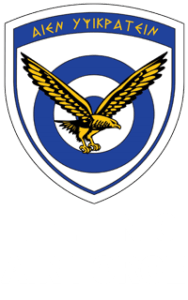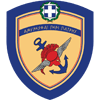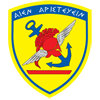
337 Squadron

Emblem
Depiction of a ghost carrying AIM-120 Air-to-Air missiles.
Call Sign: GHOST
Location
110 Combat Wing – Larisa Air Base
Established
1948
Aircraft served
- Spitfire
- F-84G
- Τ-33
- F-86D
- F-5A
- F-4E
- F-4 E SRA
Aircraft serving
- F-16 Block 52+
Mission
The mission of the 337 Squadron (SQN) is to maintain a high level of readiness and effectiveness, in order to conduct successful air operations, primarily of interception, whenever needed in accordance with current plans. It is achieved by the appropriate organization, training of personnel and maintenance of the available means and systems.
History
Its establishment began initially in liberated Greece in 1945 and was completed in 1947, when it joined the then Hellenic Royal Air Force, based in Elefsis Air Base. The official order of establishment and assumption of operational duties was dated on March 30, 1948 with SPITFIRE aircraft due to be replaced by Supermarine Spitfire Mk IX aircraft in 1949.
In early 1952 a significant change in the history of the 337SQN took place, since it successfully passed a transition stage in terms of acquiring and operationally exploiting the T-33A Silver Star training aircraft of US manufacture.
In October 1952 the 337 FB SQN redeployed from the Elefsis Air Base to the Larissa AB with F-84G aircraft in its inventory.
Αt the beginning of the year 1953, the first acrobatic flight of the HAF was established and joined the 337 Fighter Bomber Squadron.
In November 1956, the 337 Squadron redeployed from 110 Combat Wing (CW) to 112CW with F-84G and T-33 aircraft, while in November 1959 it redeployed to 115CW (Souda, Crete).
In January 1960 the Squadron was renamed to 337 All-Weather Squadron, in April 1960 it redeployed to 112CW and one month later the F-86D aircraft had been added to its Force.
By the beginning of 1967 the 337 Squadron operated on a training basis with F-5 aircraft at 111CW being at the same time in readiness with F-86D aircraft at 112CW.
The 337 All-Weather Squadron stopped operating on May 1967, 31st and was reestablished on November 1967,16th at 111CW as 337 Day Intercept Squadron with F-5 aircraft that had been delivered the following month.
The Mc-Donnell Douglas Contract for the purchase of thirty six (36) F-4E PHANTOM II aircraft was signed in March 1972. The training of technicians and 18 crews took place in the United States of America and the first F-4E aircraft landed in Andravida (117CW) on April 5th, 1974.
According to the “Peace Icarus I” Program the first deliveries armed the 338 and 339SQNs at 117CW.
On March 31st, 1978, after the agreement of the “Peace Icarus II” Program, the 337 Day Intercept Squadron stopped operating as F-5A aircraft Squadron of the 111CW. It was reestablished on September 7th 1978 at 117CW, whereas on the 11th of the same month it was redeployed to the 110CW as the 3rd F-4E aircraft Squadron.
The mission of the 337 All-Weather Squadron is to conduct air operations primarily of interception and secondarily of fighter-bombing according to the general and specific plans with the aim of contributing to the defense of the country.
The official ceremony concerning the operation of the 337 All-weather Squadron with F-4E aircraft took place on September 23rd 1978.
On 31st December 2005, the withdrawal of the F-4E SRA aircraft was decided.
On May 2006, 15th it was decided by the Supreme Air Force Council (SAFC), the reestablishment of the Squadron with F-16 Block 52+ aircraft.




